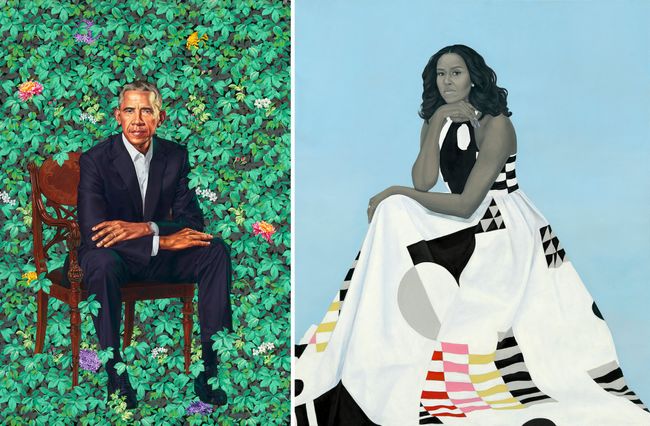February 13, 2018

Image Source: The New York Times
How often is the national conversation focused on art and artists? Perhaps the latest blockbuster film or surprise album release captures the attention of millions, but the acquisition of two portraits sparking a nation-wide conversation? A rare phenomenon. Artists and alumni from the CFA community naturally had some thoughts on the Smithsonian’s latest additions.
The Smithsonian National Portrait Gallery unveiled the latest additions to their collections: portraits of President Barack Obama and former First Lady Michelle Obama, eliciting buzz across news outlets and social media. Barack Obama selected for his portrait Kehinde Wiley, a painter whose stunning portraits of contemporary black individuals reflect the elaborate artistic traditions of high-status, aristocratic portraiture. Amy Sherald, another painter who portrays African-Americans in simple, stylized, colorful fields, captured Michelle Obama’s likeness in a captivating, glamorous portrait in grey against a cool blue background. The February reveal of the portraits prompted a sweeping conversation about the artists, their subjects, and this moment in portraiture.
Dana Clancy, Associate Professor of Painting at CFA, spends a lot of time thinking about faces. Specifically, portraits. She reflected on the recent presidential portrait reveal and spoke on the significance of this particular moment in portraiture.
“The contemporary revitalization of figure painting in general and portraiture specifically is happening as artists from a range of backgrounds paint poetic and complex portraits that slow down our looking, draw us in to empathize and to consider identity as a construction. They also often explore relations to power and the self. Artists like Kerry James Marshall use the gaze in paintings as a means to engage – and pose questions to – the spectator’s own awareness of the power dynamics of looking. Painting (especially since Goya) can make the viewer aware of looking as a form of witnessing – whether to images of troubling violence or unjust social constructions – or as a means to imagine new narratives and possible outcomes. Kehinde Wiley said it so well on NPR:
‘What we are positing here is a new vision of the possible. One which is inclusive. One that says yes to people who happen to look like me, and one that increasingly will catch fire as we go on to inspire young people to imagine new possibilities.’
“Wiley and Sherald are such different painters, but both of the new portraits of the Obamas share the way the viewer enters a double world of objective (exterior) likeness and the suggestion of interior psychology and presence through invention and painterly decisions. We are made to consider the subjective sensibility of these individuals and our own imaginative response to the paintings via fantastic elements integrated with the likeness of the Obamas. Perhaps the leaves and flowers that bring background into foreground in President Obama’s portrait and the role of abstraction in the way Michelle Obama’s gray figure and dress are depicted can draw us into looking longer and into guessing about the interior life of these public figures. Paintings function so differently in person than in digital reproductions, but my guess is that the gaze and the scale in both keep the figures feeling also very present, looking back at the viewer as we get lost in the way they are painted.
“Students in my classes have seen (and often been assigned to see) some powerfully painted and drawn examples of figurative work in the past year in New York and Boston – Kerry James Marshall’s Met show, Toyin Ojih Odutola at the Whitney, Kara Walker at Sikkema Jenkins, Barkley Hendricks and other artists (including Amy Sherald) in Legacy of the Cool on view right now at Mass Art. SVA’s own painting alum Sedrick Huckaby (CFA’97) has a large, sculpturally painted portrait currently on view at the Museum of Fine Arts as part of ‘Monuments to Us‘ that made one of my students stop to draw it, inspired by the gaze and the way it was painted.”
Students and faculty aren’t the only members of the CFA community joining in the national conversation. Alumnus and art writer Dushko Petrovich (CFA’06) commented on the Obama presidential portraits in the Times Magazine, reflecting on Wiley’s and Sherald’s portraits and the return to portraiture in the realist sense as an “increasingly essential” component of contemporary painting.
The unique platform from which the former president and first lady elevate art and contemporary artists has connected the public to the conversation of art and how we engage with it. Tapping influential African-American artists to embody their likenesses for the National Portrait Gallery is a gesture that brings the discussion of the role of artists, their craft, and their representation to the forefront.